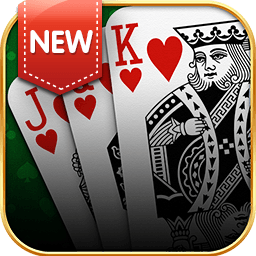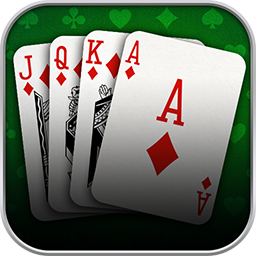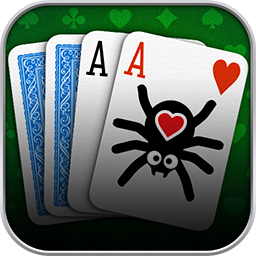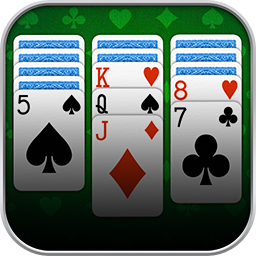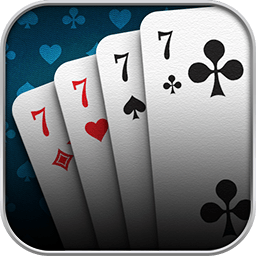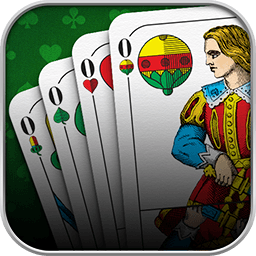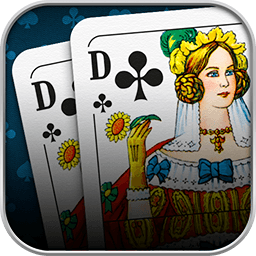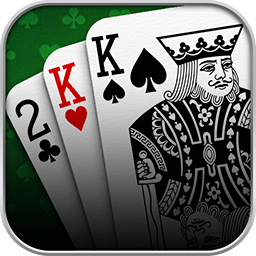While you should, of course, focus on your hand, it is crucial in Gin Rummy to keep your opponent’s hand in mind. We take a closer look at the why and wherefore here.
What Does This Mean?
Observing your opponent’s hand boils down to paying close attention to the cards your opponent draws and discards throughout the round. If you have already explored our other Gin Rummy Lessons, you will recognize this as part of the defensive style of play in Gin Rummy.
If you are new to observing, you can take a moment each turn to repeat what you already know.
For example: “Emma has already drawn the Queen of Diamonds, the Five of Spades, and the Jack of Spades. So far, she has discarded the King of Clubs, the Ten of Diamonds, and the Queen of Diamonds. That means she doesn’t have the last three cards in her hand, but she certainly has the Five of Spades and the Jack of Spades.”
With a bit of time and practice, you could even logically deduce from this information which other cards Emma is probably or probably not holding.
Beginnings Are Always Hard
Of course, this approach requires concentration, a good memory, and imagination.
If you do not possess these qualities, that is no reason to avoid Gin Rummy! On the contrary, it is an opportunity to practice these qualities while playing.
When playing with a friend offline, grab a pen and a piece of paper to note what’s been going on to master the first steps toward the Gin Rummy Overview. At the Gin Rummy Palace, you can make use of tables with the custom rule Training while you are still practicing. That way, the results won’t affect any league rankings.
Don’t forget to keep an eye on your own discards while watching your opponent. Otherwise, you’ll be hoping in vain for a card that you have long since discarded.
Observation Pays Off in Gin Rummy
While observing can be tiring at first, it’s worth the practice. You can catch up with more experienced players and memory talents. This levels the playing field and increases the quality of the competition.
If you play without paying attention to your opponent’s actions, you effectively wear a blindfold while your opponent diligently gathers information about your hand with their eyes open.
More Time, More Information
The longer your round goes on, the more accurate your image of the opponent’s hand becomes, as you may recognize patterns in their open drawing and discarding.
Intermediate Status
Let’s look at this using an example from here on out. Below you can see an image to aid the thought process. In the lower area, you can see all 52 cards available in the game.
Let’s say you’ve already played ten turns. At this point, you already know 21 cards for certain, because you have already seen them this round:
- your ten hand cards (highlighted in blue)
- the first face-up card (highlighted in purple)
- the five cards you discarded (highlighted in green)
- the five cards that your opponent discarded (highlighted in yellow)
We also listed these cards above the available cards for your overview.
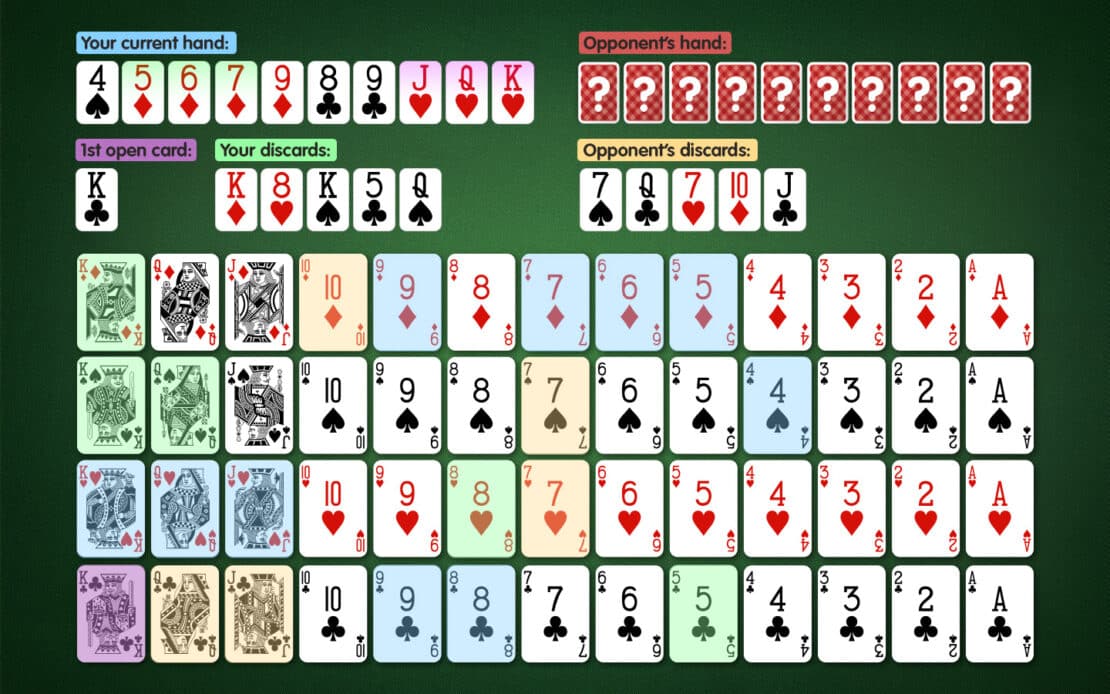
This theoretically leaves 31 options open, ten of which are in the opponent’s hand.
Drawn From the Discard Pile
But if we you were able to observe that in their five turns your opponent drew from the discard pile three times and kept these cards, you already know three of the ten cards in your opponent’s hand at the same point in the round. We are now focussing more on the opponent’s hand.
Because of that, most cards that were highlighted in color in the last step are gray now, as they can’t be in the opponent’s hand right now.
The only remaining highlight is red, indicating cards that are in your opponent’s hands for sure. You know that because they drew these three cards after you dropped them on the discard.
So, there are still 31 unknown cards in play, only seven of which are in your opponent’s hand.
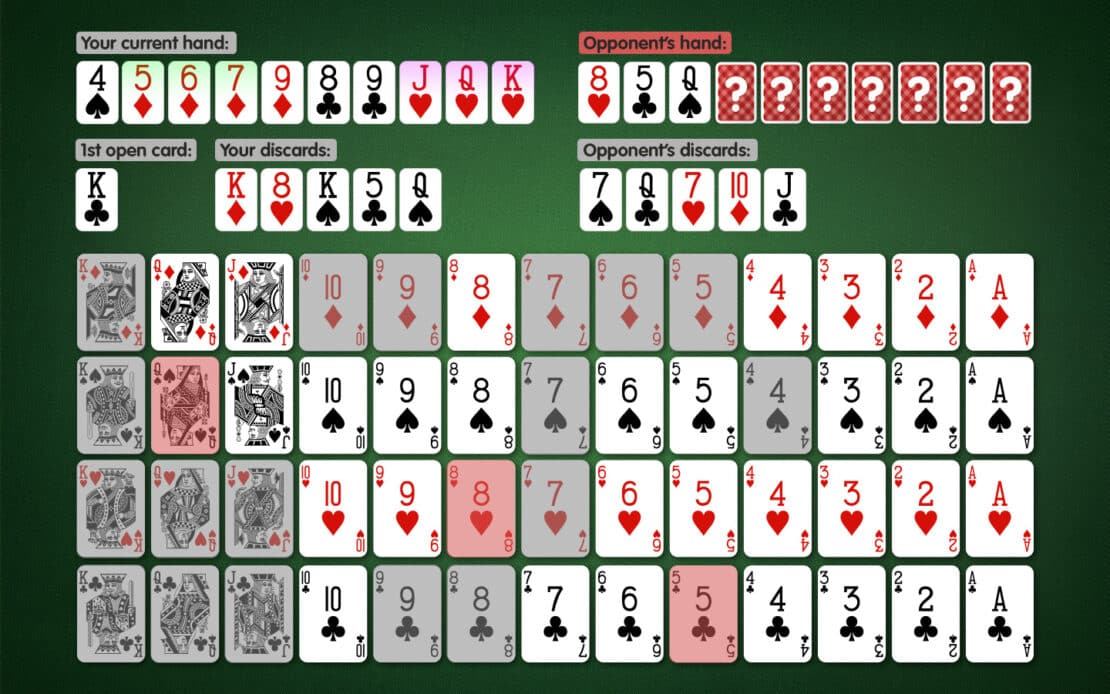
Pay Attention to Discards
Assuming that your opponent is playing logically, you may be able to narrow down the range of unknown cards in their hand based on their discards.
Patterns may emerge clearer the longer your round goes on. You could ask yourself these questions from time to time, for example:
- Are certain suits discarded while others are not? This indicates a sequence in the retained color.
- Are ranks in the vicinity of another rank repeatedly discarded in different suits? An example would be Nines and Sevens of different suits. This could indicate a group of Eights in the opponent’s hand.
Still, cards drawn face-up remain the most precise indicators of your opponent’s motives. If your opponent draws a Ten, for example, they could aim for a Group of Tens or a sequence in the Ten’s suit.
Combined with your discard observations, you can perhaps deduce over time, what is happening in your opponent’s hand.
Let’s return to our example: After a few more turns you know another card in your opponent’s hand and can exclude a few other options.
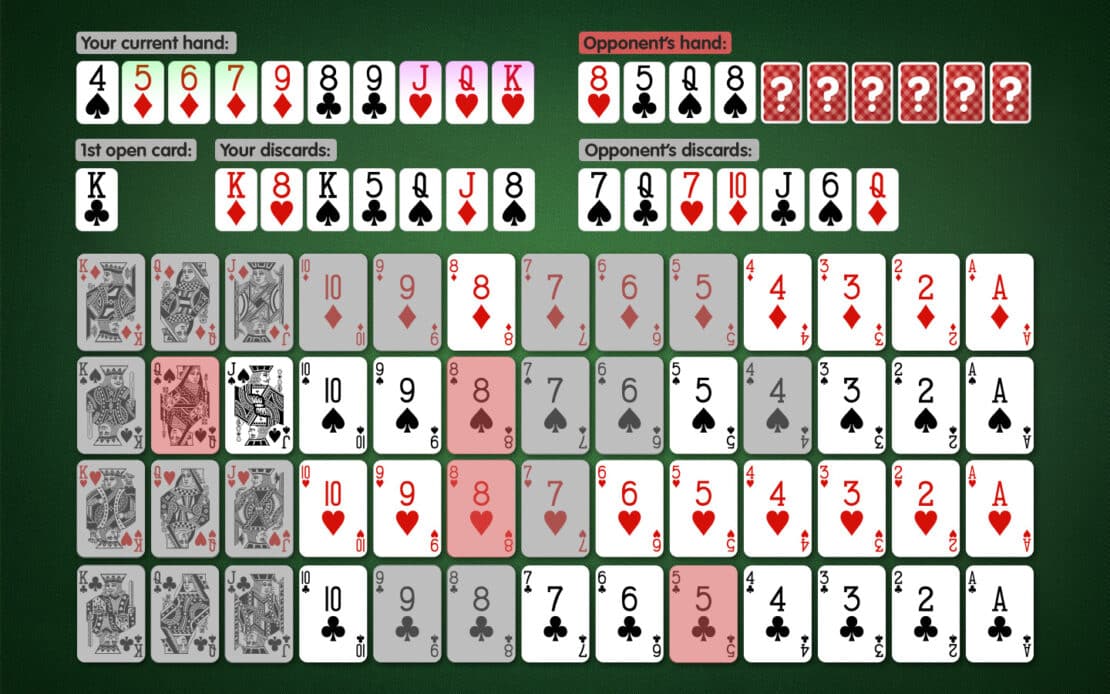
For the same point in the round, you can now see some additional light red highlights and question marks. Those indicate cards, that your opponent might have, based on the remaining available cards, previous turns, and their proximity to cards that certainly are in your opponent’s hand.
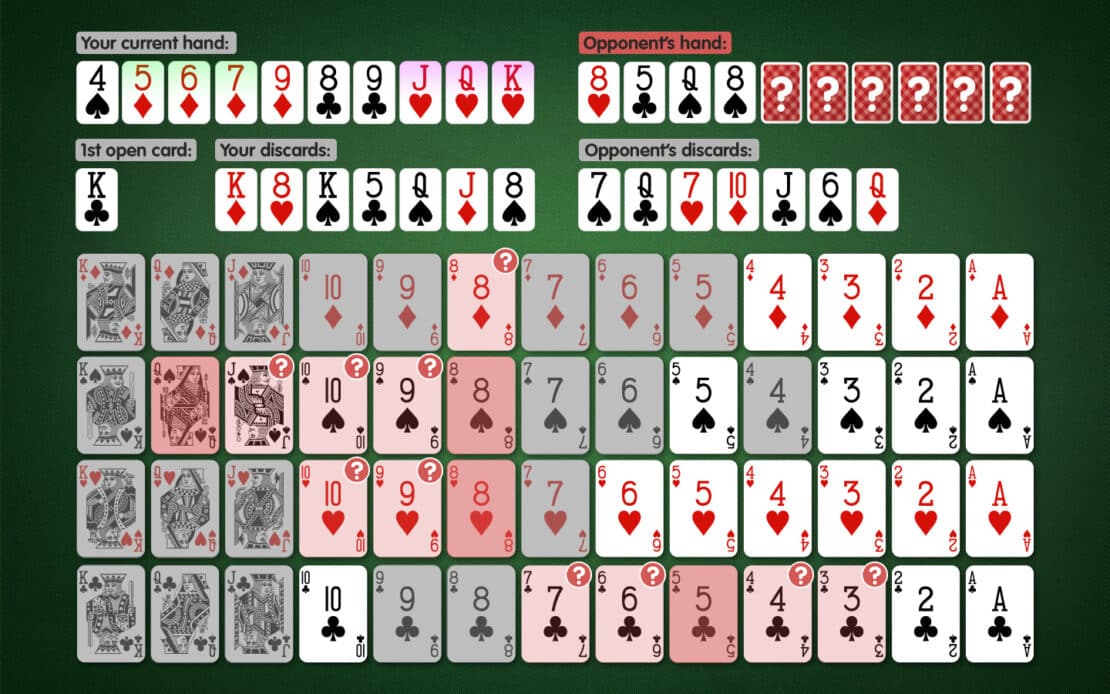
We’ll go through a few considerations about the Eight of Diamonds as an example:
- You hold the Eight of Clubs.
- Your opponent drew both of your discarded Eights.
- The only unknown Eight is the Eight of Diamonds.
- Since you hold the Five to Seven of Diamonds as well as the Nine of Diamonds, your opponent couldn’t have a Diamonds sequence using the Eight.
- But they could use it in a group of Eights together with the two Eights they drew earlier.
- So, you can assume they are holding the Eight of Diamonds and probably won’t discard it.
Using Gin Rummy Observations
You have worked hard to gather information about your opponent’s hand. What do you do with it now? That depends on your strategy in Gin Rummy: offensively towoard the Gin or defensively to offer as little target as possible?
Offensive
If you play focusing on your progress, you can use your overview of the remaining cards in the game to assess which melds can still emerge and grow and which combinations are now a dead end. This way, you can make informed decisions about drawing and discarding to make the best possible progress.
You may also notice when a Gin has become impossible or unlikely. In this case, you decide whether to go offensive and knock, risking an undercut, or become defensive, hoping to undercut your opponent.
Defensive
However, if you are more focused on minimizing your opponent’s progress, use your observations to deduce which of your cards would be the most useless to them before discarding.
In the example situation, that could look like this: Unless you draw a Nine or the Eight of Diamonds on your next turn, you can prepare to discard the Nine of Diamonds. These are the thoughts behind that:
- With two melds and three unmelded, high-value cards, it’s time to reduce your deadwood. So you are keeping the Four of Spades for now.
- The Eight of Clubs is of higher value, but it would be a more dangerous discard. After all, it could be melded in the opponent’s hand as a group with the two other Eights or maybe even with the Seven and Six of Clubs.
- So the Nines are still up for debate. Holding on to the Nine of Clubs keeps the door open for a sequence of Clubs if you happened to draw a Ten of Clubs.
- As considered above, the Eight of Diamonds could well be in tour opponent’s hand. So there is no great chance for you to join the Nine of Diamonds into your Sequence of Diamonds.
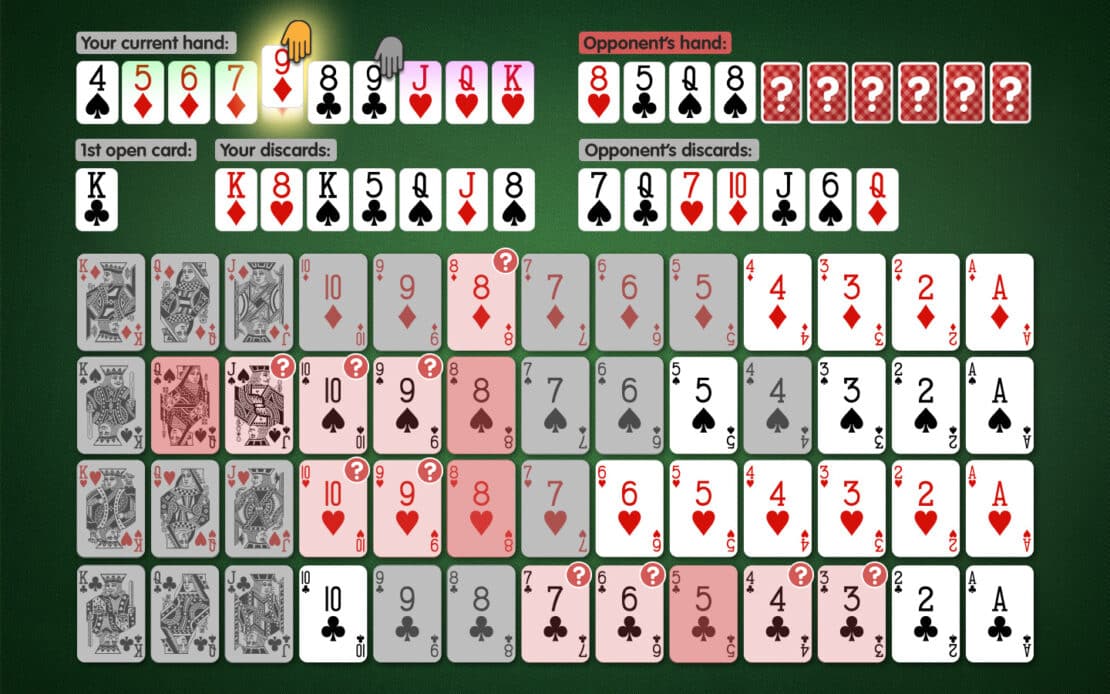
One final note: Suppose you draw a card in the second half of the round with both the rank and the suit not yet appearing on the table.
If this card doesn’t match anything in your hand either, it’s pretty likely that your opponent is holding at least two matching cards, and you haven’t seen them on the table for this reason. The defensive conclusion in this situation would be to opt for a safe discard and, if necessary, break up an existing meld as described in the lesson on defensive Gin Rummy.
See if you can pay a little more attention to your opponent’s maneuvers during your next round at the Gin Rummy Palace. Then you’re not far from becoming a Gin Rummy Pro! For even more Gin Details, we recommend a browsing session in our Gin Rummy Lessons. The basics, on the other hand, can be found in the Gin Rummy Rules. No matter what you choose, we hope you enjoy the game.

